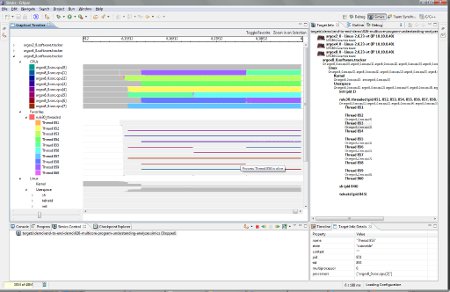Multicore simulation engine gains GUI analysis tools
May 26, 2010 — by Eric Brown — from the LinuxDevices Archive — 14 viewsWind River announced a new version of its Linux-ready, multicore oriented Simics virtualization and simulation software for embedded hardware development. Wind River Simics 4.4 adds a GUI-enabled “Analyzer” application for evaluating a virtual representation of the target hardware, as well as an extension builder that exposes Simics APIs for customization and plugin development, says the company.
In February, Intel Corp. acquired Simics maker Virtutech, and announced it would integrate the company's operations and Simics software with its own embedded software subsidiary Wind River. The virtualized systems development (VSD) simulation platform had previously been used by Wind River to develop the Wind River Hypervisor.
Compatible with both the Wind River Linux commercial embedded distribution and the Wind River VxWorks real-time operating system (RTOS), Simics supports hardware development — principally involving multicore system-on-chips (SoCs) — on ARM, Intel, MIPS, and PowerPC platforms (see farther below for more Simics background).
Wind River Simics 4.4 supports full system simulation, enabling OEMs "to undertake critical software development activities on virtual platforms, independently of any hardware development schedules, semiconductor availability constraints, or other limitations, says Wind River.
Simics Analyzer: A huge, GUI-enabled trace
The key addition to Simics 4.4 is the Wind River Simics Analyzer, providing analysis of the increasingly "heterogeneous aspect" of embedded designs, according to Wind River.
Simics Anayzer is said to provide a graphical timeline with execution details of running processes. The Analyzer is particularly useful for tracking multicore development and applications spanning multiple CPU architectures or multiple operating systems (OSes), says the company.

Wind River Simics Analyzer
(Click to enlarge)
"The Analyzer helps bring intelligence to the user, telling them what is running where and when," said Michel Genard, VP of product strategy and marketing for Simics at Wind River, in an interview with LinuxDevices. "It's basically a huge trace to analyze what's happening in the target. Much of this information was already available in Simics, but it was not always exposed or well packaged. We are exposing a lot more information from the Simics simulation, and presenting it in a way that's easier to use."
Simics Analyzer offers integration hooks with Wind River Linux and VxWorks, but also works well with other OSes and tools environments, says Wind River. The application provides statement code coverage on binary code, "without modifying or instrumenting the target system code," adds the company.
Simics Extension Builder: A plugin platform for customization
The new Wind River Simics Extension Builder, meanwhile, assists developers in building profiling tools and other specialized analysis tools and data collections, says Wind River. The application can be used to extend Simics with custom functionality via plugins, as well as to connect Simics into additional workflows and enterprise tooling environments, says the company. The Extension Builder is also said to enable integration of third-party simulators, including ISSes (instruction set simulators).
"The Extension Builder enhances our build system to offer APIs to build extensions in a much more structural way," said Genard. "It lets developers more easily connect to different flow, instruction sets, different operating systems, or other software."
Finally, Simics 4.4 adds expanded support for running multiple models in parallel for C, C++, SystemC, and DML programming environments, says Wind River. This parallel modeling support is said to be well suited for heterogeneous designs that can simulate foreign models not originally written for Simics.
Simics mini-backgrounder
Introduced in 2002, Simics is widely used in multicore processor and tools development, especially in Linux environments. In February, VDC Research released a report estimating that Simics was the market-leading virtual prototyping/simulation platform, with greater than 30 percent of total market revenue, says Wind River.
Last July, Virtutech announced a new version of Simics that supports full-system checkpointing for SystemC-based transaction-level modeling (TLM). The update also added support for MIPS64 cores, with specific support for multicore NetLogic Microsystems XLR and Tensilica Xtensa cores. (For more background on Simics, see our coverage of the Intel acquisition of Virtutech, here.)
Availability
Wind River Simics 4.4 will be available on May 31, says Wind River. More information may be found here.
This article was originally published on LinuxDevices.com and has been donated to the open source community by QuinStreet Inc. Please visit LinuxToday.com for up-to-date news and articles about Linux and open source.